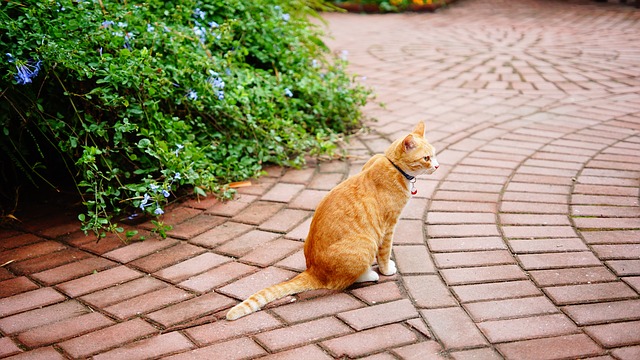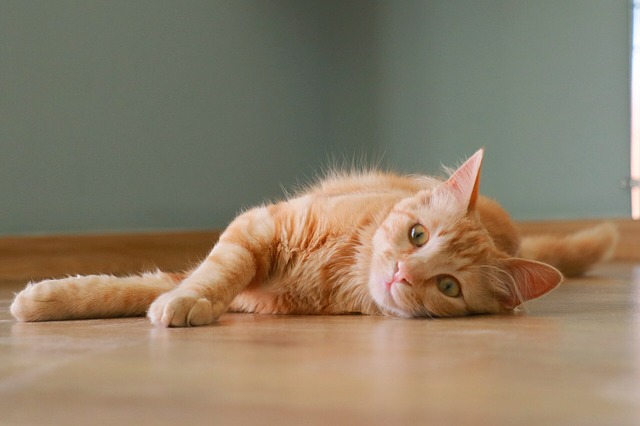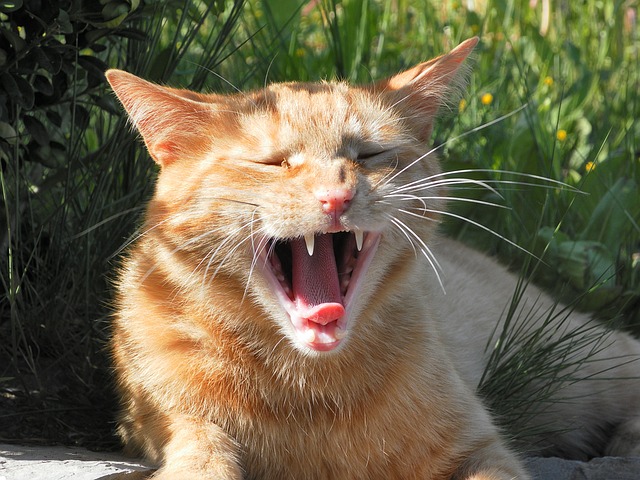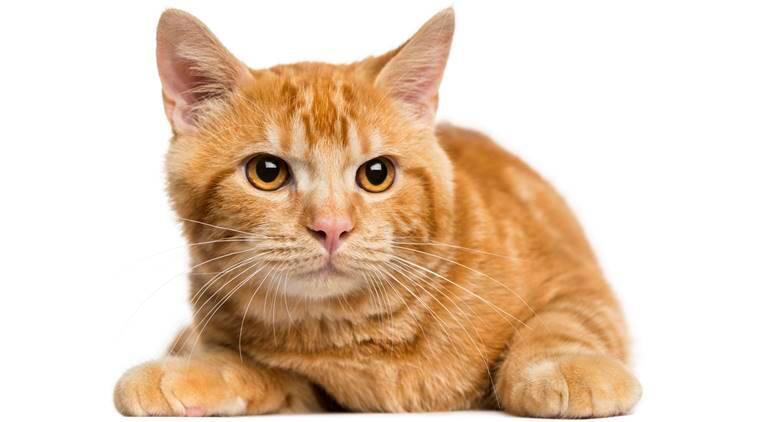Looking to own a ginger tabby cat?
What a unique color and pattern choice for a feline friend! No doubt, this one is a showstopper!
The tabby pattern combines with the ginger color to make an exceptionally beautiful cat.
In addition to beauty, tabby cats have some of the best temperaments in the feline world.
No wonder they are in almost every home you step your foot into.
They are affectionate, intelligent, a little mysterious, and playful.
On the other hand, they come with a few challenges of their own.
In this guide, we will go over the good and bad of owning a ginger tabby cat.
Before buying one, you might want to arm yourself with this information.
Where Does A Ginger Tabby Originate From?

Like other cat colors and patterns, the ginger tabby gets his markings and color from his genetic makeup.
The pattern is the result of the agouti gene which causes the cat to have bands of heavy and light pigmentation on his body.
There are four different patterns including the classic, mackerel, striped, and ticked.
The recessive gene affects the exact pattern the cat will have.
If the dominant gene is ticked, the ticked tabby pattern will mask all the other patterns.
The ginger coloring is a result of the pigment pheomelanin.
The same pigment is what gives some human beings red hair.
Typically, the pigment gives color ranging from red to cream.
The more the pigment, the deeper the color and vice versa.
Ginger Cat Breeds
Since the ginger tabby is not a breed but a coat color and pattern, it can be found in many cat breeds except those of Russian Blues and Siamese.
The most common breeds with this pattern and color include the following:
- Abyssinian
- Somali
- American bobtail
- American curl
- Bengal
- British shorthair
- Egyptian Mau
- Maine Coon
- Munchkin
- Ocicat
- Oriental shorthair
- Persian
Are All Ginger Tabbies Male?
The ginger color in cats is carried on the gene of the X chromosome.
Besides determining the gender of the cat, the gene also impacts the color and pattern of the coat.
It is for this very reason that many ginger tabbies are male.
See, a female has two X chromosomes while a male has both X and Y.
To become a ginger tabby, a male cat only needs the gene from his mom which is very easy to occur.
A female tabby, on the other hand, will require the gene from both parents making her tabby chances very low.
The stats show that for every 5 ginger tabbies, you have only one being female.
Fun fact: All ginger cats are tabbies. Many people don’t know this because some appear to have a solid color with others having tabby markings on them.
When mutation occurs, the markings will appear very faint.
In such a case, you have to be very close to the ginger cat to see the tabby markings.
Pros of Owning a Ginger Tabby

1. Beauty
Sure, all cat colors and patterns are beautiful but there’s something truly special about the ginger cat.
These adorable creatures are prized for their remarkable beauty.
They come with an adorable pink little nose that screams ‘kiss me please”, cute eyes that assure you of their love and devotions, and the all-time-favorite ginger coat with tabby markings.
Some have lip lines with freckles or black dots that present in circle shapes.
They add to the beauty of the cat in more ways than one.
Whether you end up with a mackerel, a ticked, striped, or spotted ginger tabby, prepare to take endless shots of her and add all to your Insta feed.
2. Laid-Back Attitude
If you know a thing or two about the animated cartoon character Garfield, you probably know that he is a chill cat.
He is not one to run around, climb trees, fight with other felines, and all that stuff.
On the contrary, he likes to simply lounge around, sleep, eat, and cuddle a bit.
This is your typical ginger tabby. Don’t expect too much energy from him.
If you are not into high-energy felines, this one will make your dreams come true.
Of course, you want to offer mental stimulation to your cat to help him burn off some energy and avoid obesity but this is basically a laid-back cat.
3. Friendly Nature
All tabbies have been known to have friendly dispositions. The ginger tabby is no exception.
He is very sociable and loving. Count on him to spend lots of time with you and other members of the family.
He is not high-energy though, so don’t expect him to run all over the yard with your kids on Saturdays.
But he will enjoy curling next to them or sitting on their laps as they watch their favorite TV shows.
4. Affection
Tortoiseshell cats are known to be temperamental while calico cat owners swear by their babies’ headstrong and playful attitudes.
However, when it comes to affection, we have to give it to a ginger tabby.
It is believed that tabbies are affectionate because they are friendly and love everyone they meet.
If you have ever owned one, you will agree that he is truly big on showing affection.
He can cuddle for hours on end if you let him.
Related Post: 12 Least Affectionate Cat Breeds
5. Intelligence
All tabby cats, including gingers, are smart compared to other felines.
They have a unique ability of processing information rather quickly.
This is perhaps why they respond fast when they are called by owners.
They also possess a curious nature and are always trying to experiment with a number of things around them.
Ginger tabbies also display amazing survival instincts besides being trainable.
They tend to have incredible cognitive skills as well.
Cons

1. Weight Gain
Perhaps the biggest challenge of owning a ginger tabby is the possibility of having an overweight cat.
Despite being incredibly beautiful, these little feline creatures tend to eat anything and everything they come across.
Garfield already depicted this fact for all to see.
At home, your tabby will chomp up what you offer him then follow you to the kitchen for more.
If you have meat (or anything edible) lying around in the refrigerator or one of your surfaces, he will not hesitate to knock it over and help himself.
Unfortunately, he will likely become obese if the behavior is left to continue.
Canine obesity may seem like a small matter but just like in humans, it can lead to high blood pressure, a shortened life expectancy, and diabetes.
To be safe, monitor the eating habits of your ginger cat.
In addition, portion his meals and keep a solid eating schedule.
2. Noise
If you don’t appreciate having a loud cat, you might want to stay away from the ginger tabby.
While this really depends on the individual cat, it has been shown that ginger tabbies can be noisy.
They can purr so loudly that neighbors will know there’s a cat around.
Again, you might end up with a quieter cat but if he is noisy, just know that his coat color and pattern are to blame.
Simply talk to a trainer to tame the little guy a little.
3. Clinginess Potential
Every cat owner appreciates being needed by their feline companion.
Nothing hurts more than having a cat that doesn’t have time to play with you, cuddle, or run his body over your feet.
On the other hand, a cat that is too clingy—who follows your everywhere you go and wants to cuddle all day—can be a major turn-off as well.
Sadly, ginger tabbies can be too clingy. Blame it on their attention-seeking and affectionate personalities.
Lucky for you, training will almost always solve the problem.
4. Feisty and Bossy
Another common trait with ginger tabbies is their feistiness and bossy attitudes.
There’s something about the tabby pattern that brings out these not-so-great attributes in these cats.
If you walk over to a cat rescue center and ask why many felines end up there, you will likely hear that the owners complained of their cat being too bossy and feisty.
Dealing with such a feline can be a hard task which is why you should get him trained as early as possible.
This way, you can catch the behaviors early enough and deal with them.
FAQs

Q. Are ginger tabby cats rare?
A. Not really. On the contrary, they are quite easy to find.
Q. Why is my tabby cat shedding so much?
A. All tabby cats shed. Some do it more than others.
If yours is shedding way too much, it could be because he doesn’t have enough vitamins and omega-3 fatty acids in his diet.
Infrequent brushing also leads to plenty of hair around the home which can signify a lot of shedding.
Finally, it can also mean that your fur baby is stressed.
Have him checked by the vet to know the root problem.
Q. Why are ginger cats so special?
A. Because they have a unique coloring, are majorly male, cute, friendly, and affectionate.
You get all that in one package!
Q. Why do tabby cats have an M on their forehead?
A. It is believed that a tabby cat comforted baby Jesus when he was born over 2,000 years ago.
Apparently, because he was born in a manger which was cold, the baby couldn’t get enough heat.
His mother tried all he can—added blankets, changed his diaper, and moved closer to him but he couldn’t stop crying.
A tabby cat was watching the whole thing unfold. She then jumped over to the manger and started to purr.
A few moments later, baby Jesus stopped crying.
As a thank you gift, Mary marked her initial on the cat’s forehead as a way to show the world what she’d done for her son.
There’s a second belief that the ‘M’ letter on the forehead helps the cat in the wild as it camouflages him.
This is a more sensible myth of the two.
Q. Are tabby cats indoor cats?
A. Yes, tabby cats can be perfect indoor cats.
They love the great outdoors but can adapt to indoor living quite well.
Not only does raising a ginger tabby indoors safe for the cat but it extends his life as well.
This is because he lowers his chance of getting injured, contracting diseases, and running into dangerous animals.
Simply have an expert train him to live indoors, provide enough physical and mental stimulation, and give him lots of care and attention.
Q. What color eyes do ginger cats have?
A. Blue as kittens but once they grow up, they take on different colors including bright green, copper tone, golden, and topaz stones.
The most common is green, though.
Q. At what age is a tabby cat full grown?
A. 18 months of age although at one year, they are considered adults as well.
Q. Why do ginger cats get fat? What is a healthy weight for a tabby cat?
A. They enjoy eating so much that they can easily gain weight.
Typically, a healthy tabby weighs anything from 8-12 pounds.
Some go slightly above or below the cat which is normal.
Q. How much does a tabby cat cost?
A. This depends on a number of things including the breeder, type (mixed, purebred, or designer), among other factors.
If you choose a randomly bred tabby cat, you will spend $100 or less.
Otherwise, if you go for a purebred type, expect to part with $700 and $1500.
Designer tabbies cost a lot more (upwards of $2000).
Q. How do you tell if a cat is a tabby?
A. Look for the signature tabby markings on the coat.
The most common one is the classic, which has bold swing patterns running along his sides.
The other patterns include mackerel (narrow stripes), spotted (spots), and ticked (agouti hairs on the body and tabby markings on the face).
Some of the markings are not visible but if you look hard enough, you will see them.
Also, watch out for the ‘M’ letter on the forehead.
Q. Are tabby cats related to tigers?
A. Not at all.
They have similarities but they don’t have any similarities in their genetic makeup.
Conclusion
There you have it—a detailed guide of the pros and cons of owning a ginger tabby cat.
The bottom line is that this is nothing short of a beautiful and affectionate cat.
He is intelligent, cuddly, and friendly.
On the other hand, he eats a lot, can be too clingy, feisty, and bossy.
Take your pick!
Related Posts:

Hi! I am Eleanor Price. I started this website after my cat, Louie, almost died from a case of botulism (a type of food poisoning often caused by bacteria that grow on food items). Turned out that my cat’s diet was the problem. I have made it my duty to provide the best information and recommendations about everything cat lovers need to know about their felines’ health and wellbeing. My goal is to find the most informative content on anything feline-related and share it with fellow hardworking kitty lovers.

